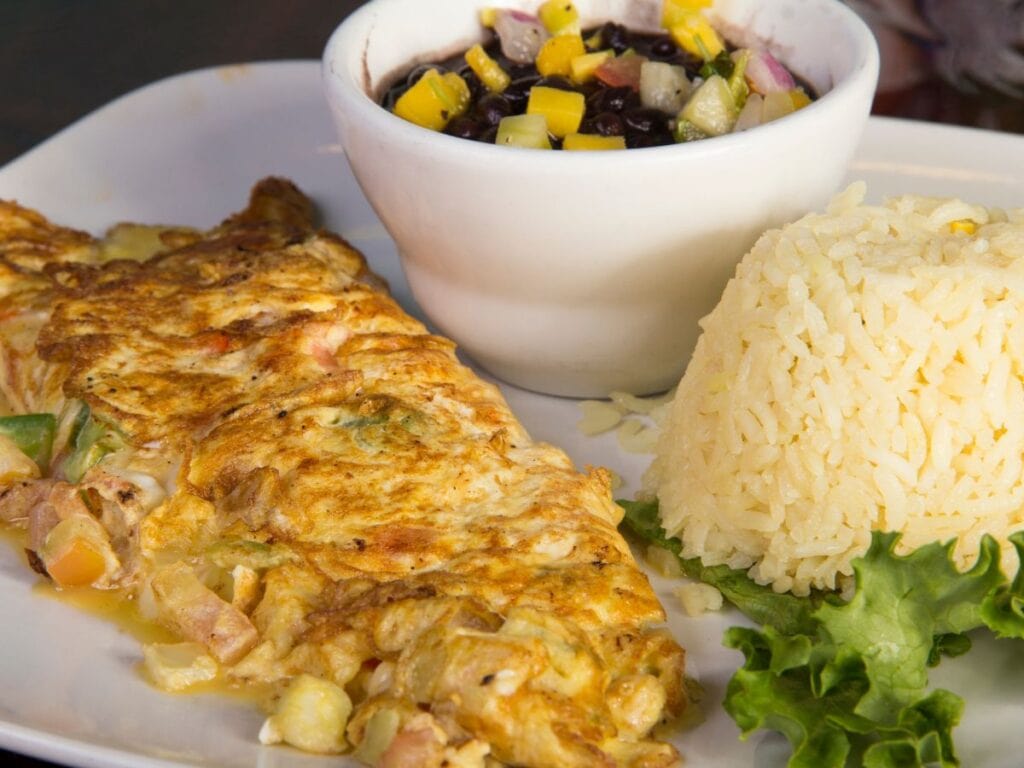How to Say Omelet in Spanish (5 Different Types)
If you’re headed to Spain anytime soon, there’s one word you’re going to need to know how to say in Spanish—omelet!
That’s because the Spanish omelet (tortilla española) is a staple in Spanish restaurants, bars, and homes. You’ll see it everywhere. Why do I know this? Well, I used to live in Spain.
I’m also a former Spanish Teacher, so I absolutely love doing deep foreign language dives into things that interest me…
That got me thinking, with Spanish omelets being so popular in Spain, do other Spanish-speaking countries also make omelets? And if so, what do they call them—omelette, tortilla, or something else?
In this post, I’ll show you at least five ways to say omelet in different Spanish-speaking countries!
How to Say Omelet in Spanish
The most standard way to say omelet in Spanish is el omelette. An obvious loanword, this word is widely used across various Spanish-speaking regions.
Pronouncing omelette in Spanish isn’t too different from English, either. The emphasis falls on the second to last syllable: oh-meh-LEH-teh.
El omelet is also another term for omelet in Spanish, pronounced oh-meh-LEHT.
Beyond omelete, there’s the universally renowned tortilla. This term, however, isn’t about the flat corn tortilla used for enchiladas or tacos! In Spain, as well as several other Spanish-speaking countries-tortilla refers to a rich, savory egg omelet.
In the rest of this post, we’ll explain 5 different ways of saying omelet in Spanish for 5 different types of omelets you can find in the Spanish-speaking world.
1. Omelette – Omelet in Mexico

In Mexico, breakfast is a meal that sets the tone for the day. And for breakfast, you can often find an array of egg dishes. From migas to huevos divorciados, and sometimes, omelettes or omelet.
This Mexican version of the omelet is typically fluffy and filled with veggies or cheese. Bell peppers, onions, tomatoes, and local cheeses are popular additions. Expect a bit of heat, with finely chopped jalapeños or serranos, and a dollop of salsa or pico de gallos. Black beans and corn tortillas often accompany breakfast dishes.
Remember that Mexico is a huge country, so what may be true in one part of the country may differ in another part! In some regions, you may hear the term “omeleta” or “tortilla de huevo” used to refer to an omelet.
Another variation you might come across is the term “omelette relleno.” This refers to a stuffed or filled omelet. The word “relleno” means “filled” in Spanish. It suggests that the omelette contains various ingredients, such as cheese, vegetables, or meats, giving it added flavor and texture.
Example:
—Desayunemos omelettes de hongos.
—Let’s have mushroom omelets for breakfast.
—¿Qué tipo de omelette te gustaría?
—What type of omelet would you like?
2. Tortilla Española – Spanish Omelete

When you think of a Spanish omelet, the tortilla española is likely the first thing that comes to mind. This dish isn’t just a staple in Spanish cuisine—it’s a part of Spain’s cultural identity.
Simple yet rich in flavor, the tortilla española is beloved from the bustling streets of Barcelona to the serene villages of Andalusia.
Imagine eggs beaten to perfection, mixed with thinly sliced, lightly fried potatoes, and a touch of onion for extra flavor.
Cooked until golden-brown, this omelet is a perfect balance of simplicity and depth of flavor.
In parts of Spain, you will encounter variations of the tortilla española. Some regions (or families) add chorizo for a smoky taste, while others include red peppers for a bit of crunch.
In this case, the word tortilla will be followed by the filling after the word, de:
- Tortilla de patata – Potato omelet
- Tortilla de patata sin cebolla – Potato omelet without onion
- Tortilla de calabacín – Zucchini omelet
Interestingly, the tortilla española isn’t confined to breakfast. In Spain, it’s enjoyed as a hearty lunch, a light dinner, or even as a tapa alongside a glass of local wine in the evening.
I personally love tortilla española and typically eat it for dinner when I visit Spain. That’s also when my host mom served it when I studied abroad in Salamanca in college.
Next time you’re in Spain or dining at a Spanish restaurant, try a slice of tortilla española.
Examples:
—Esta noche, cocinaré una Tortilla Española para la cena.
—Tonight, I’ll cook a Tortilla Española for dinner.
—¿Prefieres la Tortilla de Patata con o sin cebolla?
—Do you prefer the Tortilla de Patata with or without onion?
3. Tortilla de Huevos – Puerto Rican Omelet
In Puerto Rico, they call an omlet a tortilla de huevos. This Puerto Rican Omelet is a testament to the island’s culinary culture, often incorporating ingredients that reflect its tropical environment.
Ingredients like sweet plantains, fresh seafood, or spicy chorizo are folded into the omelet. It’s common to find this dish accompanied by a side of fried plantains or a serving of savory rice and beans, making for a hearty and satisfying meal.
Examples:
—Esta mañana, desayuné una deliciosa Tortilla de Huevos con plátanos maduros.
—This morning, I had a delicious Tortilla de Huevos with ripe plantains for breakfast.
—En nuestro restaurante, servimos la Tortilla de Huevos con un toque especial de salsa criolla.
—In our restaurant, we serve the Tortilla de Huevos with a special touch of Creole sauce.
4. Tortilla Francesa – French Omelet

The tortilla francesa, or French Omelet, is a beloved dish in many Spanish-speaking countries.
A thin omelet, it offers a lighter, simpler take. Unlike its more ingredient-packed counterparts, the tortilla francesa typically features just eggs, lightly seasoned and delicately cooked.
In Spain and beyond, the tortilla francesa appreciated for its versatility as a breakfast, a quick lunch, or a light dinner. It’s often enjoyed with a side of fresh bread or a simple salad, making it a meal that’s both satisfying and easy to prepare.
Examples:
—Después del entrenamiento, me gusta preparar una Tortilla Francesa.
—After training, I like to prepare a French Omelet.
—¿Has probado alguna vez hacer una Tortilla Francesa solo con claras de huevo?
—Have you ever tried making a French Omelet with just egg whites?
5. Tortilla Paisa – Colombian Omelette
The tortilla paisa is an omelet in Colombian cuisine, reflecting the rich and diverse culinary traditions of the country. (However, the only information we found was from one recipe blog, so we’re not sure how common the dish is.)
What sets the tortilla paisa apart is its robust combination of ingredients. It often includes staples like beans, rice, and avocado, alongside eggs.
Some variations might even include chorizo or arepas, making it a filling and flavorful dish.
This Colombian omelet is not just a breakfast dish, it’s a hearty meal that can be enjoyed any time of the day.
Examples:
—Para el almuerzo, vamos a preparar una Tortilla Paisa con frijoles y aguacate.
—For lunch, we’re going to prepare a Colombian omelet with beans and avocado.
—La Tortilla Paisa que probé en Medellín fue la mejor de mi viaje.
—The Colombian omelet I tried in Medellín was the best of my trip.
Final Thoughts on Omelets in Spanish
As you can see, saying omelet in Spanish is a little bit complicated. Each country has their own version of the egg dish. This includes fillings, cooking methods, time of day eaten, and of course—what they call omelet in Spanish!
When it’s time to order the famous tortilla de patata (potato omelet) in Spain to the tortilla de lechuga (lettuce omelet) in Chile, this language learning guide is just the beginning. Read the menu or ask a local for tips for ordering the tastiest omelet around!
Let me know if you’ve made any of these omelets, or if I’ve missed any ways to say omelet in Spanish in the comments!
